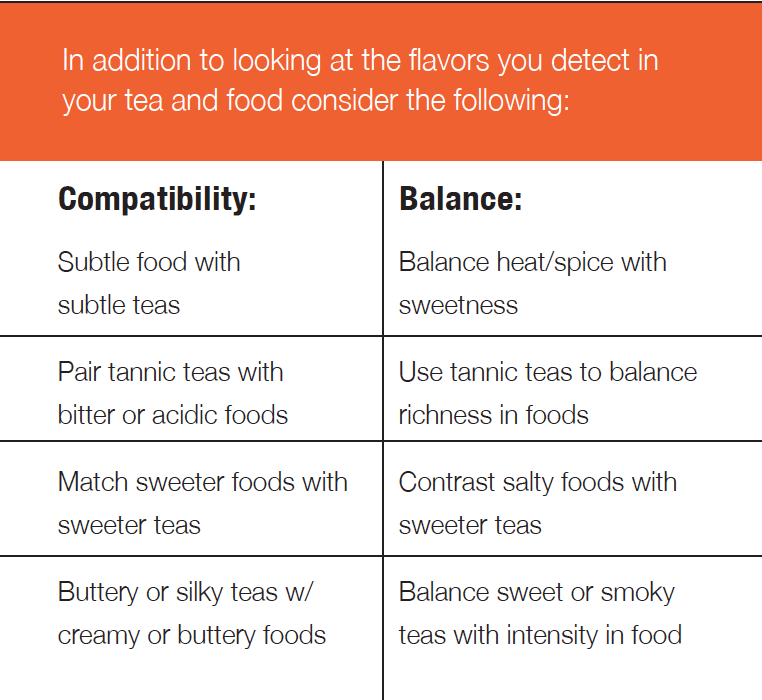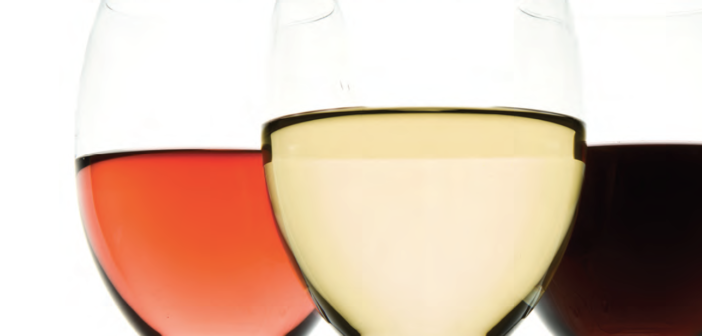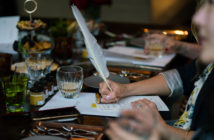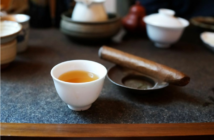Pairing food and beverages well is truly at the heart of every great dining experience. Endless books and articles have been written about pairing food and wine, yet for some reason, unfathomable to me, tea has never had the same focus, exploration and exposure.
Virtually everything that you have read, learned and experienced in the past about wine pairings will apply to your tea pairings as well. The only true differences are that you have the added dimension of heat for your tea, which can play an important role in mouth feel (think about how warmth impacts soft cheeses or chocolate on your palette), and you do not have acidity in your teas, which can play an important role in wine pairings. Tannins and astringency can play a very parallel role to wine’s acidity when pairing.
In the wine world, pairing by origin (if it grows together it goes together!) is a guideline that is heavily depended on. This can be used with tea, but would be far too limiting since this would limit the ingredients and styles of cuisine that we can pair against. The ideal scenario is to taste and determine pairings for yourself!
 Mouth feel and texture are very important. Does the tea feel full-bodied or rich on the palette, or is it lighter and cleaner? What are the tannin levels? Similarly, does the food feel, rich, light or in-between? What are the intensity of the flavors in your tea and food? Are they sharp, hot and pungent, or are they soft, subtle and delicate? How do you pair? Take it Apart! What do you taste? Approach the food and beverage and deconstruct it. Look at the dominant or subtle aspects of the aromatics and flavors. Once you’ve identified these elements they can be paired for compatibility, contrast or balance. The very best pairings often pair on multiple levels.
Mouth feel and texture are very important. Does the tea feel full-bodied or rich on the palette, or is it lighter and cleaner? What are the tannin levels? Similarly, does the food feel, rich, light or in-between? What are the intensity of the flavors in your tea and food? Are they sharp, hot and pungent, or are they soft, subtle and delicate? How do you pair? Take it Apart! What do you taste? Approach the food and beverage and deconstruct it. Look at the dominant or subtle aspects of the aromatics and flavors. Once you’ve identified these elements they can be paired for compatibility, contrast or balance. The very best pairings often pair on multiple levels.
Pairing for compatibility. When you identify a flavor component to match up, it is best if it is a subtle secondary tone. You want to tease forward the similarities, not be redundant. For example, mint in the food is particularly beautiful with a Darjeeling with a hint of mint to it, but would be redundant against a Moroccan Mint tea. Examples of flavor compatibility to bring forward similarities would be: Keemun or Yunnan with chocolate or spice. Darjeeling with berries, citrus or mint. Oolong with stone fruits, lobster or barbeque. Besides pairing for compatible flavors, you can be looking to match mouth feel or texture (astringency in tea with bitterness or acidity in food) or weight and feel (rich and silky teas with similar foods) or any other characteristic that catches your fancy.
Pairing for contrast or balance. Here instead of matching and drawing forward a characteristic, you are highlighting or balancing it. For instance, balancing a rich creamy sauce, cheese or dessert, or the richness of a cured salmon with the astringency in a 1st flush Darjeeling. Moroccan Mint or Earl Grey with chocolate, Jasmine with ginger are all examples of pairing for balance or contrast. The best possible pairings often come from multiple ‘hits’. For example, a favorite of mine is pairing a Lung Ching Dragonwell with a well-aged Gruyere or Comte. You have compatibility with the nuttiness of the cheese paired against the subtle chestnut tones of the tea. You have just enough salt in the cheese to balance the hint of sweetness of the tea, and your moderate levels of fat in the cheese balance against the moderate levels of astringency in the tea. With three or more pairing points, this pairing really sings on the palette! Keep in mind, the proper food and beverage should be chosen to compliment or balance each other in a way that the full culinary experience is enhanced. There is never however only one ‘correct’ pairing. After tasting your tea to identify the elements to play with, it is your personal preferences and continued tasting that will guide you.




